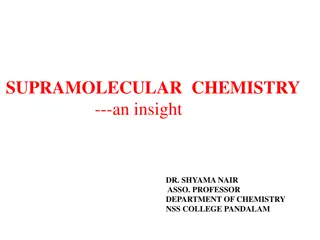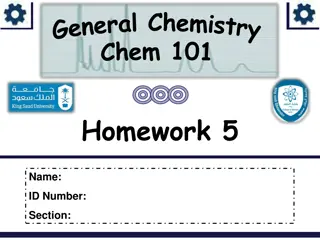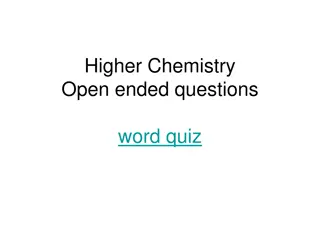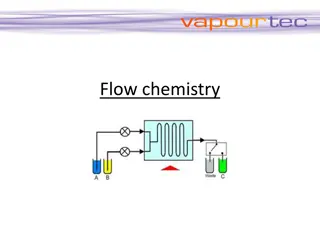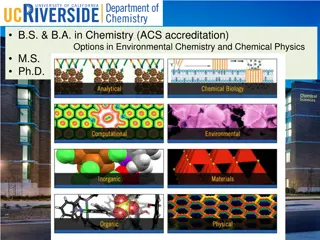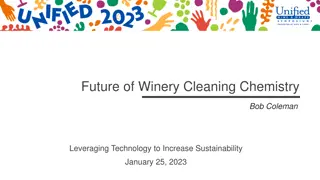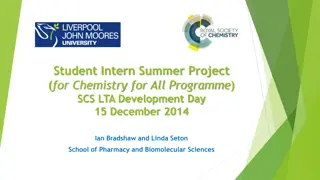Acids and Bases in Chemistry
Acids, derived from the Latin word "acidus" meaning sour, produce hydrogen ions when dissolved in water. Bases, defined as compounds dissociating into metal ions and hydroxide ions in water, have common characteristics like a bitter taste. The Brønsted-Lowry theory expanded the definitions of acids and bases, introducing the concept of donating or accepting hydrogen ions. Conjugate acid-base pairs play a crucial role in reactions, with molecules or ions related by the transfer of H+ ions.
Download Presentation

Please find below an Image/Link to download the presentation.
The content on the website is provided AS IS for your information and personal use only. It may not be sold, licensed, or shared on other websites without obtaining consent from the author.If you encounter any issues during the download, it is possible that the publisher has removed the file from their server.
You are allowed to download the files provided on this website for personal or commercial use, subject to the condition that they are used lawfully. All files are the property of their respective owners.
The content on the website is provided AS IS for your information and personal use only. It may not be sold, licensed, or shared on other websites without obtaining consent from the author.
E N D
Presentation Transcript
Book chapter: 10 Pages: 322-360
What are acids? The term acid comes from the Latin word acidus, which means sour. We are familiar with the sour tastes of vinegar and lemons and other common acids in foods. Svante Arrhenius first defined acids in 1887! He said: acids are substances that produce hydrogen ions (H+) when they dissolve in water!
Naming acids Hydrogen ions and negative ion (simple nonmetal or polyatomic) Hydro (before the name) + ic acid Hydrogen chloride (HCl) -> hydrocloric acid The name of polyatomic anion ends are ide
Naming acids An acid that contains one less oxygen atom than the common form is named as ous acid
Bases Svante Arrhenius defined bases as ionic compounds that dissociate into a metal ion and hydroxide ions (OH-) when they dissolve in water.
Naming of bases Most Arrhenius bases are formed from Groups 1A (1) and 2A (2) metals, such as NaOH, KOH, LiOH, and Ca(OH)2. The hydroxide ions (OH-) give Arrhenius bases common characteristics such as a bitter taste and soapy, slippery feel.
BrnstedLowry Acids and Bases In 1923, Br nsted in Denmark and Lowry in Great Britain expanded the definition of acids and bases A Br nsted Lowry acid can donate a hydrogen ion (H+) to another substance, and a Br nsted Lowry base can accept a hydrogen ion (H+).
A free hydrogen ion (H+) does not exist in water Its attraction to polar water molecules is strong bonds to a water Forms hydronium ion (H3O+)
Conjugate Acid-Base Pairs Consists of molecules or ions related by the loss of one H+ by an acid and the gain of one H+ by a base Every acid base reaction contains two conjugate acid base pairs because an H+ is transferred in both the forward and the reverse directions. Example: HF When an acid such as HF loses an H+, the conjugate base F- is formed. When the base H2O gains an H+, its conjugate acid, H3O+, is formed.
Strengths of Acids and Bases The strength of an acid is determined by the moles of H3O+ that are produced for eachmole of acid that dissolves. The strength of a base is determined by the moles of OH- thatare produced for each mole of base that dissolves.
Strong acids ionize completely in water Solution of strong acid contains all ions Strong electrolytes Only six common known acids Example: HCl
Weak acids Weak electrolytes Ionize slightly in water Produces only a few ions Solution of weak acid contains mostly molecules and few ions Examples: products that we use at home In carbonated soft drinks (carbonic acid) and citric acid
To sum up... Strong acid ionizes completely to form an aqueous solution of the ions Weak acid ionizes only slightly in water to form a solution that consists mostly of molecules and few ions
Strong bases Strong electrolytes dissociate completely in water Ionic compounds they give an aqueous solution of metal ions and hydroxide ions The Group 1A are very soluble in water Only a few of strong bases are less soluble in water, but these dissociate completely
Example: NaOH Used in household products To remove grease in ovens or to clean drains High concentration of hydroxide ions severe damage to the skin and eyes Directions must be followed carefully when used Advice: if you spill an acid or base on your skin or get some in your eyes flood the area immediately with water for at least 10 minutes and seek medical attention
Weak bases Weak electrolytes Poor acceptors of hydrogen ions Produce very few ions in solution Typical weak base: ammonia NH3
Acid-Base Equilibrium Reactants in acid-base reactions are not always completely converted to products Reverse reaction takes place in which products form reactants A reversible reaction proceeds in both directions meaning there are two reactions taking place As the initial reactants are consumed, products accumulate
Equilibrium Eventually, the rates of the forward and reverse reactions become equal Equilibrium is reached when no further change takes place in the concentrations of the reactants and products But...the forward and reverse reactions continue at equal rates Both reactions are shown together in a single equation (double arrow)
Le Chteliers Principle Changing the concentration of reactants or products the rates of reactions will no longer be equal Stress is placed on the equilibrium States that when equilibrium is distributed the rates of both reactions change to relieve stress and reestablish equilibrium
Summary Acids and bases Br nsted Lowry Acids and Bases Conjugate Acid-Base Pairs Strengths of Acids and Bases Strong and weak acids Strong and weak bases Acid-base equllibrium
Ionization of Water Water amphoteric Means it can act as an acid or as a base
In the ionization of water there is both a forward and a reverse reaction In pure water the concentrations (at 25 C) are each 1.0 x 10-7M Multiplied ion product constant of water Kw (1.0 x 10-14M)
Neutral, Acidic and Basic Solutions [H3O+] and [OH-] equal -> the solution is neutral Increased concentration of [H3O+] and decreased concentration of [OH-] -> solution is acidic (adding a acid) Adding a base: [OH-] increases and [H3O+] decreases -> solution is basic
The pH Scale To describe the acidity of solutions pH scale Number between 0 and 14 represents the H3O+ concentration for common solutions A neutral solution has a pH of 7.0 at 25 C An acidic solution has a pH less than 7.0 A basic solution has a pH greater than 7.0
In the lab pH meter Also other indicators and pH papers (changing color when placed in solutions of different pH values) Compare the colors to a chart
Calculating the pH of Solutions pH is negative logarithm of the [H3O+] pH = -log [H3O+] The negative powers of 10 in the molar concentrations are converted to positive numbers
Calculating [H3O+] from pH Reverse of the pH calculations For whole number pH values, the negative pH value is the power of 10 in the H3O+concentration [H3O+] = 10-pH
Chemistry Link to Health Gastric acid Contains HCl With the intake of food gastric glands begin to secrete a strong acidic solution of HCl 2000 mL of gastric juice/day may be secreted (HCl, mucins and enzymes) The secretion continues until the stomach has a pH of about 2 Optimum for activating digestive enzymes Low pH destroys bacteria that reach stomach
Gastric acid may also form under conditions of stress CNS activates the production of HCl When the contents of the stomach move into small intestine cells produce bicarbonate Neutralizes the gastric acid until pH 5
Reactions of Acids and Bases Typical reactions: acids with metals, bases and carbonate ions
Acids and Metals Reacts to produce hydrogen gas (H2) and a salt Metals: K, Na, Ca, Mg, Al, Zn, Fe and Sn (tin) Single replacement reactions The metal ion replaces the hydrone in the acid
Acids, Carbonates and Bicarbonates Products: carbon dioxide (gas), water and salt
Acids and Hydroxides: Neutralization Neutralization between an acid and a base to produce water and salt The salt is the cation from the base and the anion from the acid
Acid-Base Titration Titration we neutralize an acid sample with a known amout of base We place a mesured volume of the acid in a flask Add few drops of an indicator (phenolphthalein) colorless in an acidic solution Buret with NaOH (known molarity) and carefully add NaOH solution to the acid in the flask We neutralize the acid by adding base Neutralization has taken place when indicator changes the color from colorless to pink - endpoint
From the volume added and molarity of the NaOH we can calculate the number of moles of acid and then also the concentation of the acid
Chemistry link to Health - Antacids Used to neutralize excess stomach acid Mixtures of aluminium hydroxide and magnesium hydroxide Not very suluble in water are not damaging to the intestinal tract Others use calcium carbonate about 10% is absorbed into the bloodstream elevating the levels of serum calcium
Other antacids contain sodium bicarbonate Has tendency to increase blood pH Elevate sodium levels in the body fluids Not recommended in the treatment of peptic ulcers
Buffers A buffer solution maintains pH by neutralizing small amounts of added acid or base Blood contains buffers that maintain a consistent pH of about 7.4 If the blood pH goes slightly above or below 7.4 changes the oxygen level -> can be lethal
In the buffer, an acid must react with OH- and base must react with H3O+ However, they must not neutralize each other A combination of an acid-base conjugate pair is used to prepare a buffer Nearly equal concentrations of a weak acid and a salt containing its conjugate base
Buffers in the blood pH below 6.8 and above 8.0 cells cannot function properly -> death CO2 is produced by cellular metabolism Eliminated through lungs; some part dissolved in body fluids (saliva) forming carbonic acid Weak acid, ionizes to give bicarbonate
The concentration is closely related to partial pressure of CO2 If CO2 increases, it produces more H2CO3 and more H3O+ - lowers the pH -> acidosis Decrease in the CO2 level leads to a high blood pH Alkalosis
Summary Ionization of Water Neutral, acidic and basic solutions The pH scale Reactions of acids and bases Acid-base titration Buffers Buffers in the blood
QUIZ 2 WEDNESDAY 18.12.2019 9:00 BE ON TIME! Chapters: from midterm until today
















